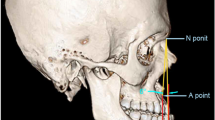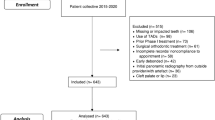Abstract
Purpose
The aim of this retrospective study was to evaluate the effects of functional orthopedic treatment on mandibular bone structure using fractal dimension (FD) analysis of panoramic radiographs.
Methods
The study material consisted of the pre- and posttreatment digital panoramic radiographs of 80 patients (mean age 10.1 ± 2.01 years; 45 girls, 35 boys) with class II malocclusion who were treated with the monoblock or twin block appliances. The following regions of interest (ROI) were selected: ROI1, condylar process; ROI2, angulus mandibulae; ROI3, corpus mandibulae; and ROI4, mental foramen. Pre- and posttreatment FD values were compared for each ROI.
Results
FD values of the mandibular condyle did not change with the functional orthodontic treatment. FD values of the mandibular corpus region had the highest pretreatment values and significantly decreased with treatment (p < 0.05).
Conclusion
Functional orthopedic treatment altered the trabeculation of the mandibular bone, but it is speculated that the changes in the occlusal forces seemed to be of primary significance for this effect.
Zusammenfassung
Zielsetzung
Ziel dieser retrospektiven Studie war es, die Auswirkungen einer funktionellen kieferorthopädischen Behandlung auf die Knochenstruktur des Unterkiefers anhand der Analyse der fraktalen Dimension (FD) von Panoramaröntgenaufnahmen zu untersuchen.
Methoden
Das Material für die Studie bestand aus den digitalen Panoramabildern vor und nach der Behandlung von 80 Patienten (Durchschnittsalter 10,1 ± 2,01 Jahre; 45 Mädchen, 35 Jungen) mit Klasse-II-Malokklusion, die mit Monoblock- bzw. Twin-Block-Geräten behandelt worden waren. Als ROI („regions of interest“) wurden ausgewählt: ROI1, Kondylenfortsatz; ROI2, Angulus mandibulae; ROI3, Corpus mandibulae; und ROI4, Foramen mentale. Die FD-Werte vor und nach der Behandlung wurden für jede ROI verglichen.
Ergebnisse
Die FD-Werte der Unterkieferkondylen änderten sich durch die funktionskieferorthopädische Behandlung nicht. Die FD-Werte im Bereich des Unterkieferkorpus wiesen die höchsten Werte vor der Behandlung auf und nahmen mit der Behandlung signifikant ab (p < 0,05).
Schlussfolgerung
Die funktionskieferorthopädische Behandlung veränderte die Trabekulierung des Unterkieferknochens, doch es wird vermutet, dass die Veränderungen der Okklusionskräfte für diesen Effekt von primärer Bedeutung zu sein scheinen.




Similar content being viewed by others
References
Geraets WG, Van Der Stelt PF (2000) Fractal properties of bone. Dentomaxillofac Radiol 29(3):144–153. https://doi.org/10.1038/sj/dmfr/4600524
Sánchez I, Uzcátegui G (2011) Fractals in dentistry. J Dent 39(4):273–292. https://doi.org/10.1016/j.jdent.2011.01.010
Demirbaş AK, Ergün S, Güneri P, Aktener BO, Boyacıoğlu H (2008) Mandibular bone changes in sickle cell anemia: fractal analysis. Oral Surg Oral Med Oral Pathol Oral Radiol Endod 106(1):e41–e48. https://doi.org/10.1016/j.tripleo.2008.03.007
Yasar F, Akgunlu F (2005) Fractal dimension and lacunarity analysis of dental radiographs. Dentomaxillofac Radiol 34(5):261–267. https://doi.org/10.1259/dmfr/85149245
Bollen AM, Taguchi A, Hujoel PP, Hollender LG (2001) Fractal dimension on dental radiographs. Dentomaxillofac Radiol 30(5):270–275. https://doi.org/10.1038/sj/dmfr/4600630
Ergün S, Saraçoglu A, Güneri P, Ozpınar B (2009) Application of fractal analysis in hyperparathyroidism. Dentomaxillofac Radiol 38(5):281–288. https://doi.org/10.1259/dmfr/24986192
Southard TE, Southard KA, Jakobsen JR, Hillis SL, Najim CA (1996) Fractal dimension in radiographic analysis of alveolar process bone. Oral Surg Oral Med Oral Pathol Oral Radiol Endod 82(5):569–576. https://doi.org/10.1016/s1079-2104(96)80205-8
Shrout MK, Potter BJ, Hildebolt CF (1997) The effect of image variations on fractal dimension calculations. Oral Surg Oral Med Oral Pathol Oral Radiol Endod 84(1):96–100. https://doi.org/10.1016/s1079-2104(97)90303-6
Huang CC, Chen JC, Chang YC, Jeng JH, Chen CM (2013) A fractal dimensional approach to successful evaluation of apical healing. Int Endod J 46(6):523–529. https://doi.org/10.1111/iej.12020
Updike SX, Nowzari H (2008) Fractal analysis of dental radiographs to detect periodontitis-induced trabecular changes. J Periodontal Res 43(6):658–664. https://doi.org/10.1111/j.1600-0765.2007.01056.x
Sansare K, Singh D, Karjodkar F (2012) Changes in the fractal dimension on pre-and post-implant panoramic radiographs. Oral Radiol 28(1):15–23. https://doi.org/10.1007/s11282-011-0075-8
Arsan B, Köse TE, Çene E, Özcan İ (2017) Assessment of the trabecular structure of mandibular condyles in patients with temporomandibular disorders using fractal analysis. Oral Surg Oral Med Oral Pathol Oral Radiol 123(3):382–391. https://doi.org/10.1016/j.oooo.2016.11.005
Yasar F, Akgunlu F (2006) The differences in panoramic mandibular indices and fractal dimension between patients with and without spinal osteoporosis. Dentomaxillofac Radiol 35(1):1–9. https://doi.org/10.1259/dmfr/97652136
Coşgunarslan A, Canger EM, Soydan Çabuk D, Kış HC (2020) The evaluation of the mandibular bone structure changes related to lactation with fractal analysis. Oral Radiol 36(3):238–247. https://doi.org/10.1007/s11282-019-00400-6
Gulec M, Tassoker M, Ozcan S, Orhan K (2020) Evaluation of the mandibular trabecular bone in patients with bruxism using fractal analysis. Oral Radiol 37(1):36–45. https://doi.org/10.1007/s11282-020-00422-5
Gelgor IE, Karaman AI, Ercan E (2007) Prevalence of malocclusion among adolescents in central anatolia. Eur J Dent 1:125–131
Mossey PA (1999) The heritability of malocclusion: part 2. The influence of genetics in malocclusion. Br J Orthod 26(3):195–203. https://doi.org/10.1093/ortho/26.3.195
Dolce C, McGorray SP, Brazeau L, King GJ, Wheeler TT (2007) Timing of Class II treatment: skeletal changes comparing 1‑phase and 2‑phase treatment. Am J Orthod Dentofacial Orthop 132(4):481–489. https://doi.org/10.1016/j.ajodo.2005.08.046
Rakosi TR, Graber TM, Petrovic AG (1985) Dentofacial orthopedics with functional appliances. Mosby, St Louis
Ahmad S, Kamble RH, Shrivastav S, Sharma N, Patil R, Goyal A (2015) Assesment of bony trabecular patternchanges seen in growing skeletal Class II malocclusion treated with twin block therapy. Int J Cur Res Rev 7(21):59–65
Wagle N, Do NN, Yu J, Borke JL (2005) Fractal analysis of the PDL-bone interface and implications for orthodontic tooth movement. Am J Orthod Dentofacial Orthop 127(6):655–661. https://doi.org/10.1016/j.ajodo.2004.02.022
Kang HJ, Jeong SW, Jo BH, Kim YD, Kim SS (2012) Observation of trabecular changes of the mandible after orthognathic surgery using fractal analysis. J Korean Assoc Oral Maxillofac Surg 38(2):96–100. https://doi.org/10.5125/jkaoms.2012.38.2.96
Faul F, Erdfelder E, Buchner A, Lang AG (2009) Statistical power analyses using G* Power 3.1: Tests for correlation and regression analyses. Behav Res Methods 41(4):1149–1160. https://doi.org/10.3758/BRM.41.4.1149
White SC, Rudolph DJ (1999) Alterations of the trabecular pattern of the jaws in patients with osteoporosis. Oral Surg Oral Med Oral Pathol Oral Radiol Endod 88(5):628–635. https://doi.org/10.1016/s1079-2104(99)70097-1
McNamara JA Jr, Bryan FA (1987) Long-term mandibular adaptations to protrusive function: an experimental study in Macaca mulatta. Am J Orthod Dentofacial Orthop 92(2):98–108. https://doi.org/10.1016/0889-5406(87)90364-7
Hirzel HC, Grewe JM (1974) Activators: a practical approach. Am J Orthod 66(5):557–570. https://doi.org/10.1016/0002-9416(74)90114-6
Tulley WJ (1972) The scope and limitations of treatment with the activator. Am J Orthod 61(6):562–577. https://doi.org/10.1016/0002-9416(72)90107-8
Shrout MK, Farley BA, Patt SM, Potter BJ, Hildebolt CF, Pilgram TK et al (1999) The effect of region of interest variations on morphologic operations data and gray-level values extracted from digitized dental radiographs. Oral Surg Oral Med Oral Pathol Oral Radiol Endod 88(5):636–639. https://doi.org/10.1016/s1079-2104(99)70098-3
Weibel ER (1991) Fractal geometry: a design principle for living organisms. Am J Physiol 261(6 Pt 1):L361–L369. https://doi.org/10.1152/ajplung.1991.261.6.l361
Ruttimann UE, Webber RL, Hazelrig JB (1992) Fractal dimension from radiographs of peridental alveolar bone: a possible diagnostic indicator of osteoporosis. Oral Surg Oral Med Oral Pathol 74(1):98–110. https://doi.org/10.1016/0030-4220(92)90222-c
Aktuna Belgin C, Serindere G (2020) Evaluation of trabecular bone changes in patients with periodontitis using fractal analysis: a periapical radiography study. J Periodontol 91(7):933–937. https://doi.org/10.1002/jper.19-0452
Tümer N, Gültan AS (1999) Comparison of the effects of monoblock and twin-block appliances on the skeletal and dentoalveolar structures. Am J Orthod Dentofacial Orthop 116(4):460–468. https://doi.org/10.1016/s0889-5406(99)70233-7
Amer ME, Heo MS, Brooks SL, Benavides E (2012) Anatomical variations of trabecular bone structure in intraoral radiographs using fractal and particles count analyses. Imaging Sci Dent 42(1):5–12. https://doi.org/10.5624/isd.2012.42.1.5
McNamara JA Jr, Carlson DS (1979) Quantitative analysis of temporomandibular joint adaptations to protrusive function. Am J Orthod 76(6):593–611. https://doi.org/10.1016/0002-9416(79)90206-9
Kwak KH, Kim SS, Kim YI, Kim YD (2016) Quantitative evaluation of midpalatal suture maturation via fractal analysis. Korean J Orthod 46(5):323–330. https://doi.org/10.4041/kjod.2016.46.5.323
Acknowledgements
The authors would like to thank Başak Oğuz for the statistical analysis.
Funding
This research did not receive any specific grant from funding agencies in the public, commercial, or not-for-profit sectors.
Author information
Authors and Affiliations
Contributions
All authors contributed to the study conception and design. Material preparation, data collection and analysis were performed by E. Bolat Gümüş, E. Yavuz, and C. Tufekci. The first draft of the manuscript was written by E. Bolat Gümüş and all authors commented on previous versions of the manuscript. All authors read and approved the final manuscript. Conceptualization and Methodology: E. Bolat Gümüş; Formal analysis and investigation: E. Bolat Gümüş, E. Yavuz, C. Tufekci; Writing—original draft preparation: E. Bolat Gümüş, E. Yavuz, C. Tufekci; Writing—review and editing: E. Bolat Gümüş, E. Yavuz, C. Tufekci; Supervision: E. Bolat Gümüş.
Corresponding author
Ethics declarations
Conflict of interest
E. Bolat Gümüş, E. Yavuz and C. Tufekci declare that they have no competing interests.
Ethical standards
This retrospective study was approved by the Ethics Committee of the Akdeniz University Faculty of Medicine (Approval Date and No.: 08 July 2020, 508). The study material was selected from the archives of the Akdeniz University Faculty of Dentistry, Department of Orthodontics. Informed consent: Not applicable.
Additional information
Publisher’s Note
Springer Nature remains neutral with regard to jurisdictional claims in published maps and institutional affiliations.
Rights and permissions
About this article
Cite this article
Bolat Gümüş, E., Yavuz, E. & Tufekci, C. Effects of functional orthopedic treatment on mandibular trabecular bone in class II patients using fractal analysis. J Orofac Orthop 84 (Suppl 3), 155–164 (2023). https://doi.org/10.1007/s00056-022-00397-4
Received:
Accepted:
Published:
Issue Date:
DOI: https://doi.org/10.1007/s00056-022-00397-4




